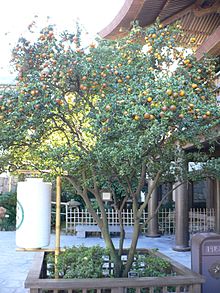- Daidai
-
The daidai (Japanese: 橙, 臭橙; Chinese: 酸橙; Korean: 광귤, gwanggyul), is an Asian variety of bitter orange. The name daidai, originally meaning several generations, originates from the fruit staying on the tree for several years if not picked. The colour of the fruit returns to green in the spring.
The daidai originated in the Himalayas. It spread to the Yangtze valley region and later to Japan.
The native Japanese word for the color orange, daidai-iro, is derived from the name of this fruit. It is used as a decoration in Japanese New Year celebrations. A daidai is placed on top of a stack of round mochi cakes, called kagami mochi. This use is believed to date from the Edo period. [1]
The fruit is very bitter, and not usually eaten, but its dried peel is used in Kampo (the Japanese adaptation of Chinese medicine), in which it is called kijitsu (枳実). It is used as an expectorant and a digestive tonic.
References
- (Japanese) 第二十八話 ダイダイ
- (Japanese) Daidai page
Categories:- Fruits originating in Asia
- Japanese fruit
- Citrus
Wikimedia Foundation. 2010.

